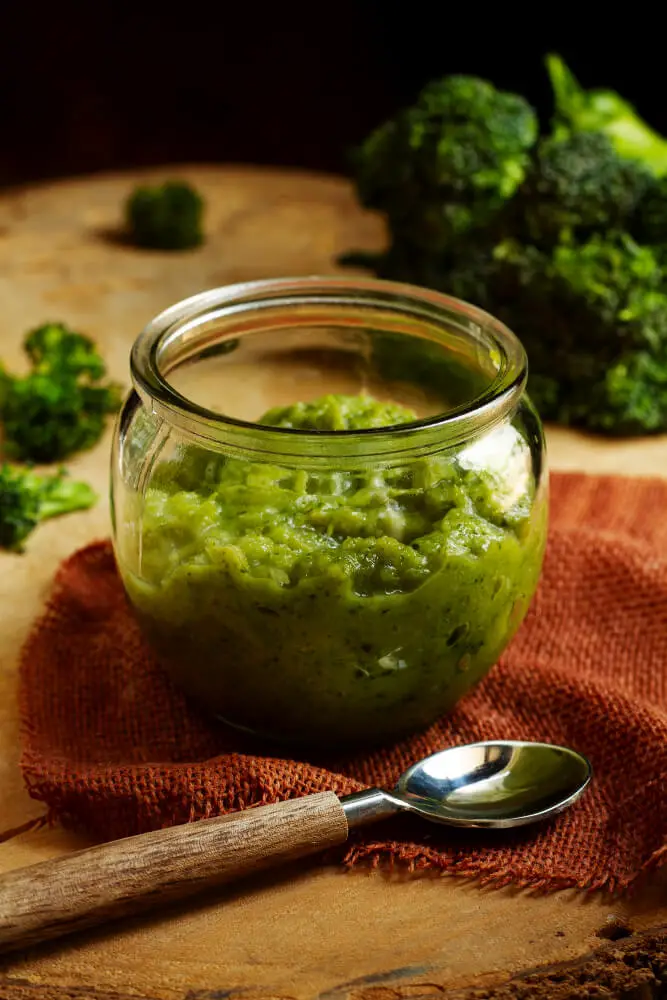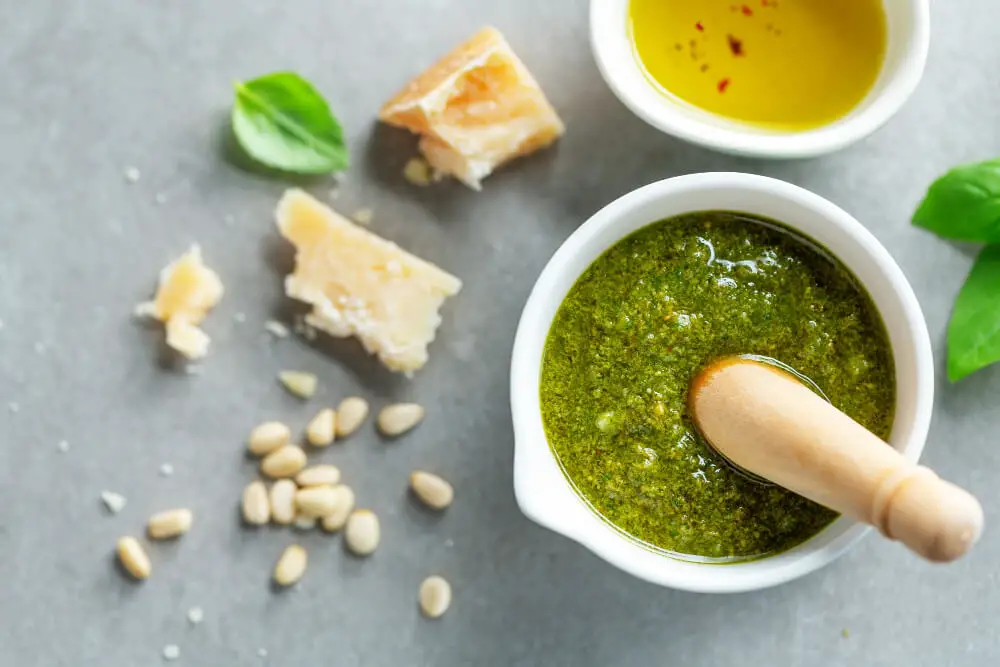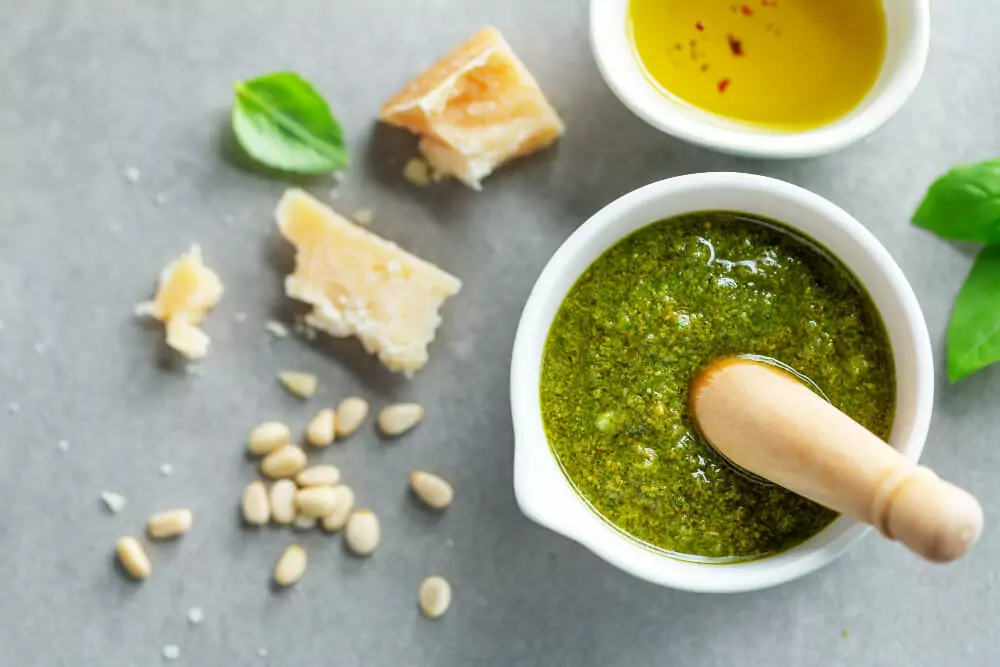Basil pesto, a vibrant and aromatic sauce, has its roots deeply embedded in Italian culinary tradition. Known for its simple yet robust ingredients, basil pesto is not only a staple in Italian kitchens but has also become a beloved addition to various dishes worldwide. Its versatility allows it to seamlessly enhance pastas, sandwiches, and even soups with its fresh, herby punch.

Ingredients Overview
The magic of basil pesto lies in its fresh and quality ingredients. At the core, you need extra virgin olive oil, finely grated Parmesan cheese, either pine nuts or walnuts, densely packed fresh basil leaves, fresh lemon juice, garlic, and a pinch of kosher salt and freshly ground black pepper. Choosing high-quality, fresh basil and a well-aged Parmesan can significantly elevate the flavor of your pesto. Toasting the nuts before blending them into the pesto will release their natural oils and add a deeper flavor.
Step-by-Step Cooking Instructions
Preparation
Start by setting up your kitchen for pesto making. Fill a small saucepan with water to the halfway point and bring it to a boil. Meanwhile, prepare an ice water bath and set up your food processor with the blade attachment, or get your blender ready. This preparation step ensures a smooth and swift cooking process.
Blanching the basil
Blanching the basil is crucial for maintaining its bright green color and tender texture. Drop the basil leaves into the boiling water for about 5 to 10 seconds. Immediately after, use tongs to transfer the basil to the ice water bath. This quick change in temperature stops the cooking process and sets the vibrant color.
Blending ingredients
To blend, start by placing the dried, cooled basil leaves into the food processor, adding chopped garlic, toasted nuts, and a squeeze of lemon juice. Pulse the ingredients until they are coarsely chopped. Gradually pour in the olive oil while the machine runs on low, being careful to maintain some texture without over-processing.
Recipe Tips
To preserve the bright green color of the basil, blanch and shock it in ice water as described. This technique locks in the hue and ensures your pesto looks as fresh as it tastes.
Adjust the ingredients to suit your taste preferences. Add more garlic for a punch, or increase the cheese for a creamier texture.
What to Serve With This Recipe
Basil pesto pairs wonderfully with classic spaghetti or a bowl of zucchini noodles for a lighter fare. It’s also excellent as a spread on a crusty baguette or stirred into a risotto. For a creative twist, try it as a topping on grilled chicken or a flavorful addition to your morning eggs.
Storage Solutions
Store basil pesto in an airtight container in the refrigerator for up to a week. For longer storage, freeze it in an ice cube tray, then transfer the frozen cubes to a freezer bag, keeping them handy for future use. This method ensures you have fresh pesto on demand without any compromise in taste or texture.
Frequently Asked Questions
Handling common issues and substitutions: If your pesto is too thick, add more olive oil in small increments. For a nut-free version, consider using seeds like sunflower or pumpkin.
Advice on nut allergies and cheese alternatives: For those with nut allergies, seeds can be a safe alternative. If you’re avoiding dairy, nutritional yeast can replace Parmesan to maintain that cheesy flavor profile.
Homemade pesto invites a world of culinary creativity. Don’t hesitate to experiment with different herbs and nuts to find your perfect blend. Whether drizzled over a summer salad or mixed into a warm pasta dish, homemade pesto adds a touch of rustic Italian charm to any meal. Embrace the simplicity of this delightful sauce and let it inspire your kitchen adventures.

Ingredients:
½ cup extra virgin olive oil
½ cup finely grated Parmesan cheese
⅓ cup pine nuts or walnuts toasted
2 cups basil leaves densely packed
Juice from half a lemon
1 to 2 cloves garlic chopped
Kosher salt to taste
Black pepper freshly ground, to taste
Instructions:
- Preparation: Begin by filling a small saucepan with water to the halfway mark and bring it to a rapid boil. Meanwhile, set up an ice water bath nearby and assemble your food processor with its blade attachment or have your blender ready.
- Blanching the basil: Place the basil leaves into the boiling water just long enough for them to wilt, about 5 to 10 seconds. Quickly remove them using tongs and plunge them into the ice bath to halt the cooking process.
- Drying the basil: Thoroughly dry the basil by wrapping it in paper towels and squeezing out the moisture. Then, transfer the dried basil to your food processor along with the garlic, toasted nuts, and lemon juice.
- Blending: Pulse the mixture until it breaks down into small pieces. While maintaining a low speed, gradually add the extra virgin olive oil to the mixture. It’s crucial to avoid over-processing to retain a bit of texture in the pesto.
- Adding cheese and seasoning: Move the blended basil mixture to a bowl. Stir in the Parmesan cheese and season with kosher salt and black pepper according to your preference. For a slightly smoother texture, you might consider adding a bit more olive oil.
- Final touches: Your pesto is now ready to be served fresh or stored for later use (refer to the storage tips in the “Notes” section).
- This basil pesto, with its vibrant and fresh flavors, serves as a perfect complement to pasta dishes, a spread for sandwiches, or as a dip. Enjoy crafting this delightful sauce that brings a touch of Italy to your table.

Basil Pesto Recipe
Ingredients
- ½ cup extra virgin olive oil
- ½ cup finely grated Parmesan cheese
- ⅓ cup pine nuts or walnuts toasted
- 2 cups basil leaves densely packed
- Juice from half a lemon
- 1 to 2 cloves garlic chopped
- Kosher salt to taste
- Black pepper freshly ground, to taste
Instructions
- Preparation: Begin by filling a small saucepan with water to the halfway mark and bring it to a rapid boil. Meanwhile, set up an ice water bath nearby and assemble your food processor with its blade attachment or have your blender ready.
- Blanching the basil: Place the basil leaves into the boiling water just long enough for them to wilt, about 5 to 10 seconds. Quickly remove them using tongs and plunge them into the ice bath to halt the cooking process.
- Drying the basil: Thoroughly dry the basil by wrapping it in paper towels and squeezing out the moisture. Then, transfer the dried basil to your food processor along with the garlic, toasted nuts, and lemon juice.
- Blending: Pulse the mixture until it breaks down into small pieces. While maintaining a low speed, gradually add the extra virgin olive oil to the mixture. It’s crucial to avoid over-processing to retain a bit of texture in the pesto.
- Adding cheese and seasoning: Move the blended basil mixture to a bowl. Stir in the Parmesan cheese and season with kosher salt and black pepper according to your preference. For a slightly smoother texture, you might consider adding a bit more olive oil.
- Final touches: Your pesto is now ready to be served fresh or stored for later use (refer to the storage tips in the “Notes” section).
- This basil pesto, with its vibrant and fresh flavors, serves as a perfect complement to pasta dishes, a spread for sandwiches, or as a dip. Enjoy crafting this delightful sauce that brings a touch of Italy to your table.


